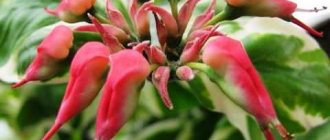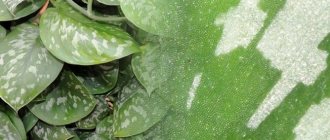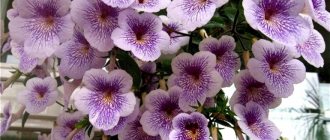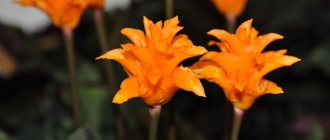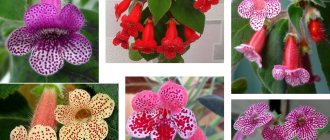Calathea crocata. Photo Calathea belongs to the Marantaceae family. The homeland of calathea is South America, where it grows in tropical rainforests. The plant is hidden from the scorching sun by the spreading branches of tall trees.
Calathea got its name from the word “calathos”, which translates from the Greek “basket” - its leaves were used in ancient times for weaving.
It is a herbaceous perennial plant with many varieties, tuberous and rhizomatous. The leaves grow on elongated petioles and are usually pink or purple on the underside. Blooms from early spring to mid-summer, depending on the species. If the conditions are suitable for her, the flowering period lasts up to 2-3 weeks. The inflorescences are inconspicuous: small flowers are compactly collected in spike-shaped inflorescences. Their color is varied.
| The growth rate is low, up to 7 new leaves per year. |
| Blooms from early spring to mid-summer, depending on the species. |
| The plant is grown with difficulty. |
| It is a perennial plant. |
Caring for calathea at home. Briefly
Calathea at home requires special attention; if care requirements are not followed, problems will arise and the plant may die:
| Temperature | 16-24°C in summer, about 16°C in winter, at least up to 10°C. Avoid temperature changes. |
| Air humidity | From 60%. Maintained by regular spraying - at least 3 times a week. Do not wet varieties with terry leaves, but humidify the air next to them. |
| Lighting | Moderate, keep away from direct sunlight. The optimal location is 2 meters from the window in a western direction. |
| Watering | In summer - 2-3 times a week, in winter once is enough. Do not allow water to stagnate in the pot. The water is soft and warm. |
| Priming | With the addition of sand or peat, breathable. When preparing it yourself, mix: leaf soil - 2 parts, peat - 1, sand - 1. |
| Feeding and fertilizer | During the growing season, a liquid preparation diluted 1:2 is required every 10-15 days. An excess of calcium and nitrogen is unacceptable. |
| Transfer | For young plants - every year in February or March. Next - after 2-4 years, when the pot becomes too small for the root system. |
| Reproduction | By dividing the bush when replanting, so that each plant has several leaves and 2-3 full roots. When propagated by seeds, they need to be germinated at 20-24°C. |
| Features of cultivation | In summer, the plant can be taken out into the open air - into the garden, onto the balcony, but protected from drafts. Loves the humidity of the bathroom. The leaves are folded at night. They are easy to damage, wipe with care. |
Kalateya Varshevich.
Photo For successful cultivation, you should study the care rules in more detail.
Photo gallery
In the warm season, calathea feels comfortable at an air temperature of +20–25 °C, in winter not lower than +16–18 °C. In conditions of high humidity, the maximum permissible is +30–35 °C. The lower limit that a flower can survive is +16 °C, after which the roots will begin to rot.
The daylight hours of this plant should last 10–14 hours, so in the cold season you need to use additional lighting. If there is insufficient lighting, the flower stops growing and sheds its leaves.
Calathea needs high air humidity - at least 60%, and preferably 90–95%. Therefore, the air near the flower needs to be sprayed frequently, especially in winter. You can also increase the humidity level by placing a container of water next to the flower.
During the flowering period, you need to feed the calathea with fertilizer for flowering plants, such as Agricola, once every 14 days. Afterwards, the faded flowers should be trimmed, leaving 5 cm and removed completely when they dry out.
Caring for calathea at home. Details
Indoor calathea is not the most capricious plant, but it is not unpretentious either.
If the temperature, humidity, or light levels deviate from its normal level, the calathea may get sick and die. Some varieties are hardier and cope better with indoor conditions than others, such as Makoya. The main problem with growing in apartments is dry air during the cold season due to radiators and heaters. Its leaves have a large area from which evaporation constantly occurs. In tropical forests, losses are compensated by moist air, but in a dry room the process is too intense. The root system does not have time to replenish reserves, which is why the leaves begin to dry out.
Such features require a more attentive attitude to the plant and compliance with care requirements.
Calathea flowering
Calatheas produce small flowers of various shades - they depend on the type of plant.
Makoya, wonderful and mosaic calathea have white, tubular-shaped inflorescences released from the base of the leaves. Saffron calathea is notable for its bright orange flowers, and zebrina has lilac flowers. To increase the flowering period, flower growers use one trick. Usually such measures bring good results in the case of saffron calathea. It blooms for 2-3 months. When its shoots have grown by more than 15 cm, in mid-August the pot is moved to a darker place for 10 weeks.
Watering is reduced to a minimum. At this time, the flower will create new buds. Upon returning to the previous bright place, resume regular watering. After another 2 months, the calathea will bloom.
Temperature
Calathea at home loves warmth and does not tolerate drafts and temperature changes. In summer, the normal temperature for it is considered to be 22…24°C. In winter, it is optimal to maintain 16…18°C.
If the temperature is above 20 degrees, then it is necessary to provide the flower with additional air humidification.
Spraying
Spraying is useful for calathea, and even a warm shower will benefit the plant. But this only applies to varieties with smooth leaves. Terry representatives should be protected from contact with water drops on the surface. In this case, the best option is to humidify the air around the plant.
Lighting
The calathea flower at home does not tolerate the sun; direct exposure to the rays can be destructive for it.
The leaves react painfully - they curl up, their color changes and becomes paler. Burns will be visible on the surface. When choosing a place for a pot, preference should be given to a western or eastern window, but not on the windowsill, but a couple of meters from it.
The room should be light enough. If you place the plant in a dark corner, it will need additional lighting from artificial sources for at least 12-14 hours a day.
The fluorescent lamp should be installed at a distance of 20 cm from the leaves.
Watering
You should be extremely careful about watering. Homemade calathea does not tolerate either overdrying or excessive moisture or stagnation of water in a pot or tray.
Fleshy leaves absorb water in large quantities, so a lack of moisture poses a threat to the health of the plant. If there is an excess, there is a growth arrest and a depressed state. The leaves become covered with spots, which indicates the beginning of rotting of the root system.
To avoid problems with watering, you should choose a light soil substrate for the flower. It should resemble the soil of the calathea's natural habitat. They grow on loose, light soils that do not retain water. For a plant, stagnation of moisture is much more dangerous than its lack. They are prepared for drought - the root system has tuberous processes that satisfy the need for water if necessary.
There is no need to water the plant until the soil in the pot dries out after previous moistening.
Calathea pot
The pot should be chosen to be small, since calathea has a superficial root system. Because of this, the excess volume of soil risks turning sour. A low and wide option would be ideal. It is better if it is clay - in such a container there is less risk of water stagnation.
If the roots of an adult plant appear through the drainage hole, then the pot is small and the plant needs to be replanted.
Soil for calathea
The soil should be light, loose, water- and breathable. The easiest way to prepare your own substrate is this recipe: leaf soil, peat and sand in a ratio of 2:2:1. Additives such as sphagnum, crushed pine bark, coco soil, and pieces of charcoal enrich the mineral composition of the soil. Store-bought soil may not be suitable for calathea; coarse sand must be added to it to loosen it.
Feeding and fertilizer
For calathea, home care should be accompanied by periodic improvement of soil quality. Organic fertilizers are beneficial, but an excess of salts can be detrimental to the flower. Fertilizing is carried out with liquid products in half the dose recommended by the manufacturer.
The frequency of procedures is once every 2 weeks.
Calathea transplant
Frequent transplants are harmful to the plant and can be difficult to tolerate.
The young flower must be transferred annually to a new pot, more suitable in size for the grown root system. When replanting, you should not remove the soil from the roots to avoid damaging them, but place them in a new container with a lump of earth. Be sure to equip the pot with a drainage layer to remove moisture. An adult plant is replanted every 2-4 years , depending on the intensity of growth.
Trimming
Calathea leaves are cut off if they are completely dry. When transplanting a plant and propagating by division, all dry and diseased parts of the plant are removed from the bushes.
Is it possible to leave Calathea without care during the holidays?
Long-term lack of care can cause irreparable damage to the health of the plant, resulting in its death. Calathea cannot be watered “in reserve” - excessive moisture will lead to rotting of the roots. Lack of moisture is also harmful to the flower. If the absence of hosts lasts 3-5 days, the plant will cope. But a longer stay without care is unacceptable.
Brief description of cultivation
- Bloom . Most species are cultivated as decorative foliage plants. And the species Calathea saffron and Calathea Varshevich bloom in January–February.
- Illumination . Slight shading.
- Temperature regime . It grows well at normal room temperature, but it should not be less than 16 degrees.
- Watering . During the growing season, it is necessary to water abundantly, and in winter - moderately.
- Air humidity . Its level should be about 90 percent. To increase humidity, wet pebbles are poured into the tray, and a flower pot is placed on it, or its foliage is regularly moistened with a spray bottle.
- Fertilizer . The plant is fed once every 2 weeks in April–August; for this purpose, complex mineral fertilizer for decorative deciduous plants is used.
- Rest period . Not clearly expressed. As a rule, it begins in September and ends in January.
- Transplant . Young specimens are subjected to this procedure once a year, and older specimens – once every 2 or 3 years.
- Reproduction . By cuttings, dividing the bush and seed method.
- Harmful insects . Scale insects, thrips and spider mites.
- Diseases . Rhizoctoniosis. If you do not properly care for a flower, problems with its foliage may begin.
Calathea propagation
The plant can be propagated in three ways: division, cuttings and seeds.
Reproduction of calathea by dividing the bush
Most often, calathea is propagated by dividing the bush - this is the most effective way, which allows the seedling to quickly adapt and begin to grow. Only healthy and large plants are suitable for division.
The bush is disassembled by hand so that each part has 2-3 leaves and several high-quality roots. Divisions that are too small take root very poorly and may die.
The seedling is immersed in light soil of peat and sand, the upper part is covered with a plastic bag, maintaining high humidity underneath. When growth and the appearance of new leaves are noticeable, the plant is transferred to normal conditions.
Propagation of calathea by cuttings
Propagation by cuttings is available for calathea. In this case, a stem with a length of 15 cm is selected. It should have a growing point and 3-4 leaves. The stem is planted in a substrate of peat and sand.
The pot is left in a warm and very humid place until the cuttings take root.
Growing calathea from seeds
Not the most popular way to propagate calathea is through seeds. They are laid on the soil surface for several weeks, slightly pressed down on top, and covered with glass on top to create a greenhouse effect. After germination, they should be sprinkled with 1 cm of soil.
When sprouts appear, you need to start airing: remove the glass for 30 minutes. If the plants have reached 2-3 cm in length, then it’s time to replant them in separate pots and care for them as usual.
Problems and mistakes when growing
Calathea Makoya is considered a capricious house plant that is not suitable for beginners. It is difficult to maintain high humidity, indirect light for 12-16 hours and the appropriate temperature.
The earthen lump should not be overcooled, so a cold window sill will not work, even if the room is hot. Experienced flower growers create the necessary conditions for this flower by placing it in a special florarium. But, since not everyone can afford it, Makoya sometimes gets sick.
Diseases and pests
Calathea leaves turn yellow.
Photo Calathea can get sick, and to save the plant, you need to know the signs and causes of their occurrence:
- the tips of the leaves turn brown - the air is too dry;
- the calathea leaves have drooped and wrinkled - the air is too dry;
- Calathea leaves dry out - dry air during the heating season;
- calathea leaves curl - excessive lighting;
- white-yellow spots appear on the leaves - excessive lighting;
- leaves become covered with dark spots - excessive soil moisture;
- leaf petioles are strongly elongated - insufficient lighting;
- brown spots on calathea – sunburn;
- brown dry edges of leaves - irregular watering, hard water, dry air;
- Calathea leaves have become lethargic - cold air or temperature changes.
The cause of the deterioration of the calathea can be pests. It is susceptible to attack by spider mites - its most dangerous enemy, as well as mealybugs, scale insects and whiteflies.
Mr. Summer Resident recommends: Calathea - the flower of happiness
Chinese scientists claim that calathea has hot magical energy, thanks to which it can warm a person, protect against colds, prevent the formation of blood clots and resolve them.
This plant purifies the surrounding air from harmful impurities. It is recommended to grow this flower for people suffering from insomnia; it has a beneficial effect on the nervous system, brings peace to the house, and helps to find something to do for the soul.
According to the teachings of Feng Shui, the calathea should be located in the southeast or east. In this case, she will stand guard over the health and well-being of the family.
Types of homemade calathea with photos and names
Here are the most popular representatives of Calathea. They adapt to life in a city apartment more easily than others.
Calathea saffron, crocata
It has dark green leaves, violet-purple on the underside. Bright orange flowers are produced on long petioles.
Calathea painted
The oval leaves are up to 20 cm in length, in the center they have a symmetrical color of light and dark green stripes, framed along the edges with a white or pink pattern.
Makoya
A lush bush with painted leaves - the light green surface is decorated with dark ovals and thin lines. The lower part is burgundy. Blooms with purple inflorescences.
Calathea striped
Straight vertical stems grow up to 40-60 cm. Large oblong leaves also reach 40 cm. Their color is dark green, with light stripes over the entire surface.
Calathea leopardis
Elongated leaves with a pointed tip. Light green with dark stripes. Plant up to 50 cm high.
Calathea Burle Marx or "Blue Ice"
Named after landscape designer Burle Marx. He created not only unique projects for gardens and parks, but was also an ardent admirer of beautiful flowers .
The color of the leaves is dominated by pastel tones of green with silver tints , but the flower petals amaze with a delicate bluish tint, reminiscent of frozen ice.
Pink-colored roseopicta or medallion
It is distinguished by unusual leaves: on the reverse side they are reddish, and the upper part of the plate has circular patterns consisting of various shades of green .
Calathea is a plant that is valued not only for its unique leaves and flowers, but also has a beneficial effect on people on a mental level. This beauty is capable of absorbing the energy of aggression , bringing peace not only to the family, but also to the work team.
It symbolizes family happiness and home comfort. In addition to indoor floriculture, calathea varieties are used in floristry , since their stems remain fresh in water for a long time.
Houseplant Calathea - description
From Latin the name “calathea” is translated as “basket”. This name is not because the indoor flower itself looks like a basket, but because of the leaf veins. They are dense and thick, so in ancient Greece they were actually used for weaving baskets.
Calathea belongs to the arrowroot family, and therefore, like all representatives of this family, it loves moisture very much. Perennial. Nowadays it is no longer used for weaving baskets, but is used for decorating rooms: it has large, beautiful leaves, and breeders have developed various varieties - with red leaves, pink leaves, pink veins and many other various decorations.
Calathea is beautiful, but rather capricious in terms of moisture levels. But it also has a positive feature: unlike many ornamental plants, it prefers shade rather than sun.
It is also known as the flower that raises its leaves at night. This is true: at night its leaves curl, and in the morning they bloom again. Because of this, she got the nickname “prayer flower”: as if he prays in the evenings and mornings.
What does calathea look like?
The plant is quite large, sometimes even resembling not a flower, but a tree: it reaches eighty centimeters in height, and the leaves are large, round, up to thirty centimeters in length. They grow in several stems-shoots from one rhizome.
The colors of the leaves can be very different, since there are many varieties of decorative calathea. Breeders also try to develop varieties with different patterns on the leaf blades, so two plants belonging to the same calathea species can look completely different.
Where it grows - the birthplace of the plant
Central and South America, shady, humid tropics.
How indoor calathea blooms
As with many plants whose main decorative value is their leaves, potential owners have the question “does calathea bloom or not at all?” Of course it blooms.
Flowering time: late spring, summer. The flowers are small, collected in small delicate spikelets, and come in pink, white, purple, orange and other colors.
Is Calathea poisonous or not?
It has poisonous juice. However, in Asian countries, the leaves of this plant are even used as plates, they wrap food in them, so calathea is absolutely safe - you are not going to chew the leaves to get juice from them. But you should not allow animals or children near the plant - they are not so prudent.

